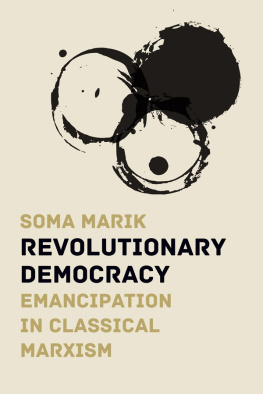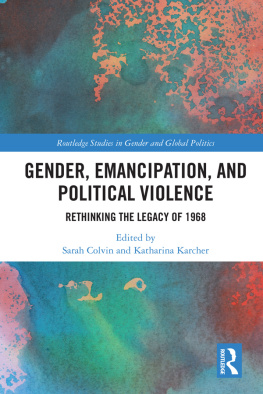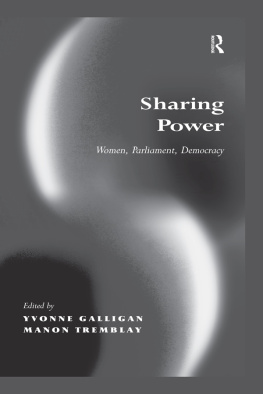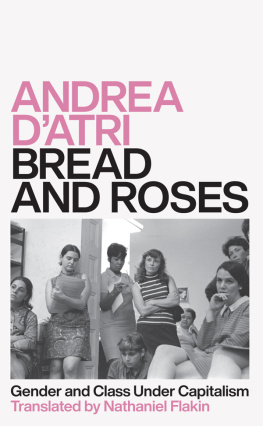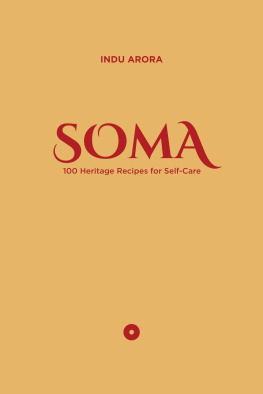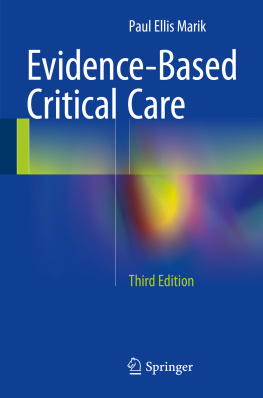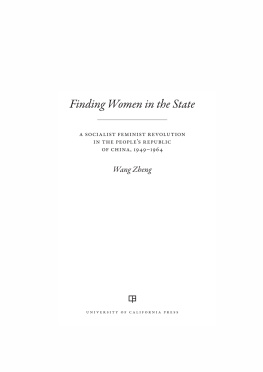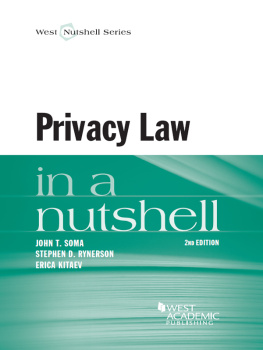REVOLUTIONARY
DEMOCRACY
REVOLUTIONARY
DEMOCRACY
EMANCIPATION
IN CLASSICAL MARXISM
Soma Marik

2018 Soma Marik
Published in 2018 by
Haymarket Books
P.O. Box 180165
Chicago, IL 60618
773-583-7884
www.haymarketbooks.org
info@haymarketbooks.org
ISBN: 978-1-60846-730-3
Trade distribution:
In the US, Consortium Book Sales and Distribution, www.cbsd.com
In Canada, Publishers Group Canada, www.pgcbooks.ca
In the UK, Turnaround Publisher Services, www.turnaround-uk.com
All other countries, Ingram Publisher Services International,
IPS_Intlsales@ingramcontent.com
This book was published with the generous support of Lannan
Foundation and Wallace Action Fund.
Cover design by Rachel Cohen.
Library of Congress Cataloging-in-Publication data is available.

FOREWORD
It is with great pleasure that I introduce to the reader this very scholarlybut also profoundly politically relevantbook.
For too long, particularly in the West but not exclusively there, the revolutionary core of Marxs thought has been obscured by interpretations that professed to investigate superstructural elements at the expense of political engagement.
From the beginning of the twentieth century the ongoing debate centred on the relationship of the party to the proletariat and the development of a revolutionary consciousness among the working class. Even those who seemed to believe in a semi-automatic breakdown of capitalismKautsky or Luxemburg in their different wayswere enthusiastic about party organization (Kautsky) or such tactics as the mass strike (Luxemburg). But with the growing reformism of large sections of the working class in the West, including the Trade Union leadership, and the lack of the clear polarization of society, Lenins idea of a vanguard party which would instil revolutionary ideas into the working class became attractive. With the success of 1917, the Leninist model in which the party incarnated the consciousness of the working class (as theorized by Lukcs) became dominant. In the Soviet Union under Stalin, this conception was used to implement a violent revolution from above. In China the party, claiming to embody the consciousness of a largely non-existing proletariat, tended to become equally divorced from the people, in spite of such efforts as the Cultural Revolution. Those in the West, like Korsch and the Council Communists, who retained their commitment to workers self-emancipation, were disillusioned. The Frankfurt School and the structuralists both reflected this lack of faith in the revolutionary potential of the working class. The only thinker to unite predominant interest in the superstructure with active commitment to politics was Gramsci.
It is in this context that the return to the revolutionary and democratic core of Marxism in the present work is welcome. In the careful dissection of the ways in which Marx and the Bolsheviks united theory and practice, Dr. Marik gives us an important contribution to our understanding of the relation of Marx and the Bolsheviks to democracy. There is an excellent discussion of Marxs views on the Paris Commune. The contributions of Engels, Bebel and Zetkin are well explicated. And Dr. Marik clearly shows the effect of the fateful ban on factions within the party in 1921no control over the leadership and growing bureaucratization. It is no surprise, therefore, that the thinker for whom Dr. Marik has the most admiration is Luxemburg. It should be noted also that the analysis is much enriched by the careful attention to the question of gender displayed in the various political, and historical contexts discussed.
This is a major work of scholarship. The footnotes alone embody an excellent bibliographical guide to the vast literature involved. This book is unsurpassed as a guide to the theoretical and practical achievements of Marx and the Bolsheviksand to their shortcomings. I recommend it to all potential readers unreservedly.
David McLellan
Visiting Professor of Political Theory,
Goldsmiths College, University of London
PREFACE TO THE 2018 EDITION
This book was in the making for many years and was produced in a different age. Originally conceived as a PhD thesis in 1986, when the Soviet Union was still in existence, its focus was on the links and discontinuities between the theories and praxis of Marx and Engels and that of Lenin and the Bolsheviks. Also, it aimed to examine the recurrent charge that Lenins ideas gave rise to Stalinism. In India, the bulk of the Marxist left was split between parties of Stalinist and Maoist origin (and often continued to be Stalinist or Maoist). Some of them had moved or were moving round to the position that democracy had only one possible form, which was parliamentary democracy, and that the Stalinist bureaucratic dictatorship had its roots in Lenin and the Bolsheviks practices and theories. Others, in wishing to be orthodox, defended the dictatorship of the proletariat in the authoritarian regimes of Stalin, Mao, or the Khmer Rouge. One could discern similar trends in left parties and intellectual currents of Stalinist origin worldwide. So a preliminary hypothesis was that there had in fact been a revolutionary democratic politics that existed in the nineteenth century, within which the working class played a major role, and that classical Marxism was strongly involved in that politics. It was further my position that Lenin and the Bolsheviks relationship with Marx, Engels, and the left wing of international Social Democracy was something requiring close study, rather than making a priori assumptions based on later communist practice. I had the great fortune of having Sipra Sarkar as one of my teachers of Western political thought as well as Soviet history. While critical of the Bolsheviks for many of their ideas and deeds, Sarkar insisted on challenging such a priori thinking and pointed to the need to look at primary texts and also to contextualize them. Her lectures on liberalism also highlighted the distinctions between liberalism and democracy as political movements and ideologies, so that liberal democracy was shown to be a questionable doctrine of very recent (often post-1917) origin. Many of these ideas would find their way into the work as it was completed in the mid-1990s.
Only after the completion of the thesis did it dawn on me that my own engagement with the womens movement and my positions within it found no resonance in the work. There followed some years when I was working on Marxist women and the revolutionary movement in Germany, Russia, India, and elsewhere. My political position was also being shaped by the impact of globalization in India. From 1986 to 1995, while researching for my thesis, I found much of the anti-Stalinist left to be dogmatic in their rejection of feminism or dismissive towards it and the womens movement. Furthermore, they often held an instrumental attitude to women in or around the movement and its organizations. Within the far left organizations, including those critical of Stalinism, there were sometimes women comrades personally committed to the womens liberation movement, but the organizations collectively often displayed a Marxism or a Leninism that continued to absorb a fair amount of sexism. At the same time globalization and the increasing brutality of capitalist exploitation made it evident to me that the feminist movement in its growing NGO-ized form was not an answer. It appeared that there were two inadequate forces at work. There was a womens movement that, in its search for ways to provide assistance to masses of women, had from the end of the 1980s been turning to donors and their funds, created NGOs, which, despite laudable intents, ended up as hierarchical organizations more concerned with lobbying and carrying out partially donor-driven agendas than with building the militant mass movements of earlier times. And there was an anti-Stalinist Marxism which appeared to claim that uttering working-class self-emancipation was enough, without looking at special oppressions that kept the class fractured and which had to be addressed in an autonomous way.
Next page
